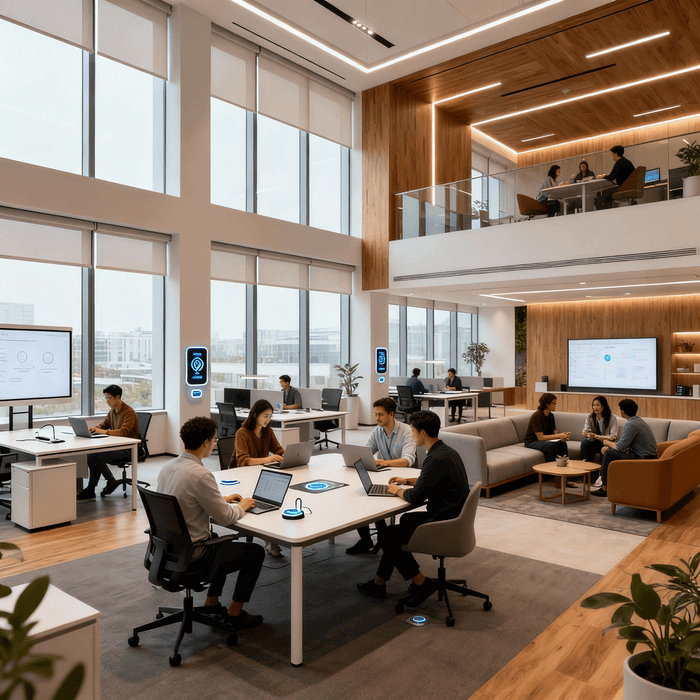Smart design isn’t just about aesthetics; it’s about creating systems and spaces that make work more efficient, intuitive, and satisfying. When design choices are guided by intelligence and purpose, they don’t just look good; they directly enhance how people think, move, and collaborate.
Whether it’s a warehouse built for speed and safety or an office designed to minimize distractions, smart design helps people and technology work together seamlessly. It’s the bridge between comfort and capability, and it’s redefining productivity across industries.

- It Improves Workflow by Reducing Friction
Smart design makes every task simpler by removing unnecessary steps. Clear pathways, intuitive layouts, and digital systems ensure that workers spend less time navigating obstacles and more time doing what matters.
In modern facilities, automated systems and well-organized layouts mean fewer delays and faster results. Warehouses, for instance, are now adopting smart lockers to make equipment sharing and storage effortless. Instead of wasting minutes looking for tools or waiting on managers for access, employees can retrieve what they need instantly, and get back to work.
- It Creates Environments That Support Focus
Smart design recognizes that human attention is limited. By controlling factors like lighting, acoustics, and spacing, it helps people stay focused and avoid fatigue.
In offices, natural light and sound-absorbing materials improve concentration and reduce stress. In manufacturing and logistics, well-planned workstations prevent clutter and limit distractions. The result is a smoother flow of concentration and fewer mental interruptions, which are both essential ingredients for high performance.
- It Uses Technology to Automate Routine Tasks
Automation is one of the most powerful aspects of smart design. When technology handles repetitive or administrative work, people can focus on problem-solving, creativity, and communication.
Motion-activated lighting, digital inventory systems, and connected devices all help eliminate inefficiencies. In smart facilities, digital management systems track equipment, monitor conditions, and trigger alerts before problems arise, keeping productivity high while downtime stays low.
- It Boosts Collaboration Through Adaptable Spaces
Collaboration thrives when spaces are flexible. Smart design enables teams to switch between solo work and group sessions without disruption.
Adjustable desks, modular furniture, and multipurpose zones help people move fluidly between tasks. In digital environments, connected tools and shared dashboards allow remote and on-site workers to coordinate effortlessly. When space adapts to workflow rather than the other way around, teamwork becomes more natural and effective.
- It Reduces Waste and Supports Sustainable Efficiency
Efficiency isn’t just about time; it’s also about resources. Smart design embraces sustainability by reducing waste and promoting longevity. Energy-efficient systems, reusable materials, and optimized layouts all contribute to lower running costs and a smaller environmental footprint.
This sustainable approach not only helps businesses save money but also creates cleaner, healthier environments that improve employee morale and wellbeing, both proven factors in maintaining long-term productivity.
- It Enhances Organization and Accountability
Smart design encourages responsibility by making organization effortless. Systems that track equipment, manage space, and log activity keep everyone accountable.
For example, workplaces that use smart lockers benefit from improved transparency, as managers can see which tools are in use and by whom, helping to reduce loss, downtime, and confusion. This kind of visibility creates order and reliability, empowering staff to work confidently and efficiently.
- It Adapts to Change and Growth
The best designs evolve with the business. Smart layouts and modular systems make it easy to expand, reconfigure, or repurpose space as operations scale. Whether it’s adding new technology, accommodating hybrid work models, or redesigning workflow to meet new demands, flexibility ensures productivity never stalls during transitions.
Smarter Design, Smarter Results
When every design decision supports how people work, productivity becomes an outcome rather than an objective. Smart design creates harmony between people, processes, and technology, ensuring that every element contributes to better performance.
From adaptable layouts to intelligent storage, these innovations demonstrate how thoughtful design transforms not only spaces but the efficiency within them. Ultimately, smart design doesn’t just make work easier; it makes it better.







